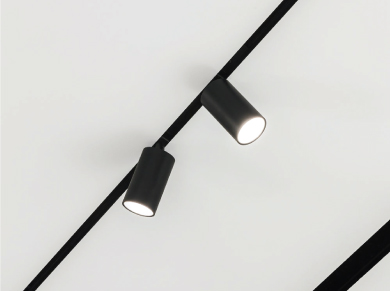
Track Lighting Guide
Everything you need to know!
When speaking of track lighting, we refer to the kind of light that consists a various types of light fixtures placed on a rail. These rails can be more visible or less, depending on the style of the interior design itself, as they can become an integral part of it, offers an important Architectural Accent lighting design and function.
What is Track Lighting?
In track lighting, fixtures attach to a continuous track that contains electrical conductors that power multiple lights along the track. Tracks can be mounted to walls or ceilings and come in both straight and curved formations. The heads (or lights) can be positioned (and repositioned) in various ways along the track, as well as pivoting to project light in different directions.

Two major parts of track lighting!
Track Rail: The track is wired to power and holds the conductors for the heads. This is the part that’s mounted to the ceiling or wall, with the opening facing down or out.
Heads: The heads are the lamp-holding fixtures like EOS, connected to the power source inside the track with two metal tabs that also lock and secure it in place on the track.

Track Rails wiring options:
Single, dual or triple circuits are the three options for track rails. Single circuit means all the track fixtures turn on and off together, while dual and triple circuit gives you more control options by allowing you to turn on a set number of fixtures at a time.

7 Benefits of LED Track Lighting:
- Aesthetics: variety of colors, materials, shapes and sizes in order to be attractive and match different commercial designs.
- Versatility: able to change easily, and be used for many different purposes, with the capability of combining with many other accessories to give you the perfect match.
- Energy Saving: Track lighting system concentrates light where it is most needed and avoids therefore over illumination where it is not required.
- Highlighting features: LED track lighting offers you the ability of highlight certain aspects of your space, such as paintings, sculptures or pieces of furniture.
- Flexibility: with track lighting fixtures, light can be moved all along the rail and it can be tilt of rotate in different directions to suit your tastes.
- Ideal for small spaces: Track lighting fixtures are overall very thin, perfect for small spaces since it can be mounted where convenient.
- Easier installation: Track light system gives you the ability to add or remove fixture at any time, without adding any junction boxes or electrical connections.

Over the decades, track lighting has evolved. Exhibiting more flexible, slimmer designs along with advancements in LED lighting technology. High-CRI LED light coupled with adjustability, makes track lighting a prominent choice for displaying art in galleries and museums or products in retail stores.
In this article : LED, Track Light, Accent Light, Track Rail, wire, circuit, Flexibility, LED Technology, High-CRI
